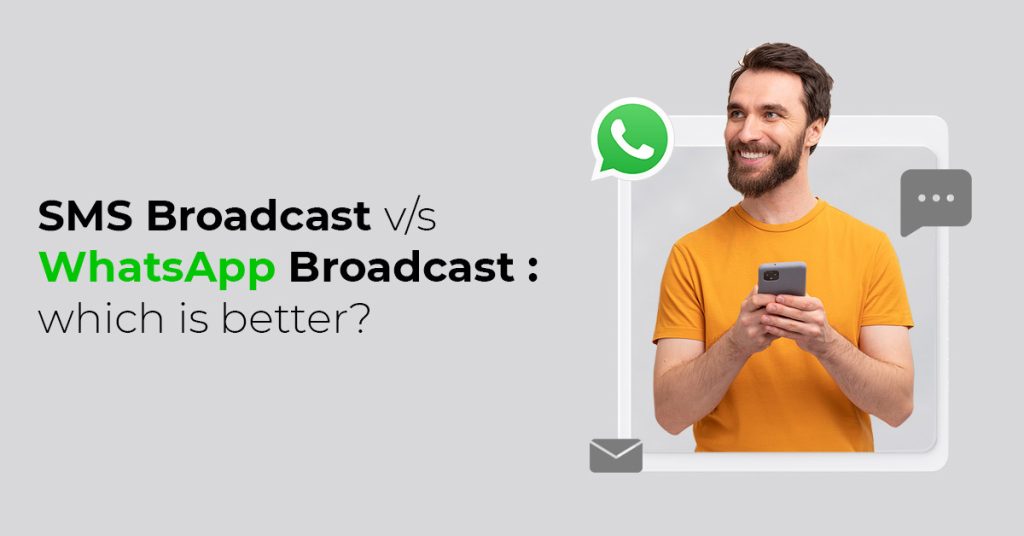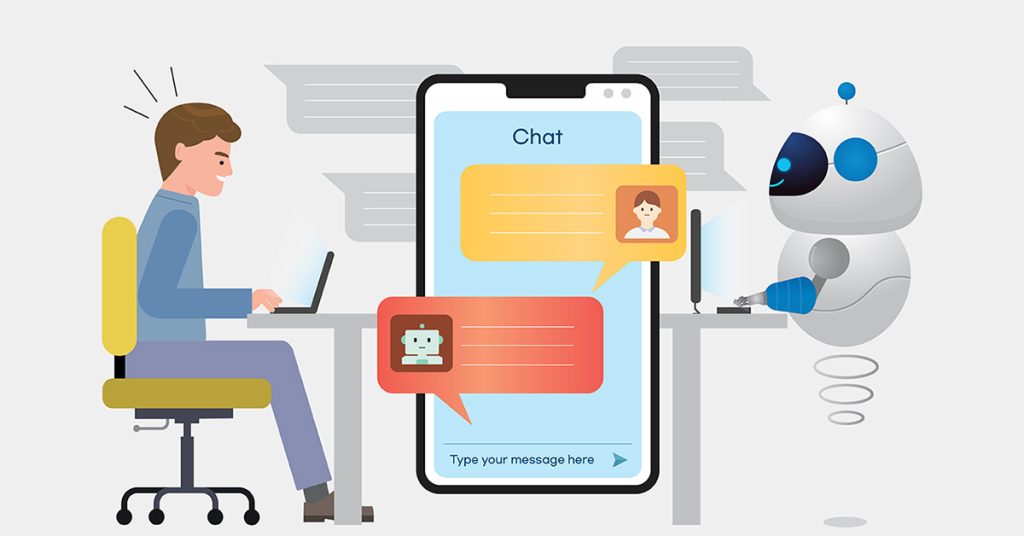- SMS Broadcast:
- Benefits of using SMS broadcasts:
- Difference between SMS, MMS & Cell Broadcasting:
- Limits of SMS Broadcasting:
- What is WhatsApp broadcasting?
- Benefits of WhatsApp broadcasting?
- Limits of WhatsApp broadcasting?
- Difference Between SMS Broadcasting & SMS Broadcasting:
- Points to be considered while choosing between SMS broadcasting & WhatsApp broadcasting:
- Role of Botbuz Chatbot in SMS Broadcasting & WhatsApp Broadcasting:
SMS Broadcast:
SMS broadcasting is a method of sending text messages to a large number of recipients at the same time. It is also known as bulk SMS or mass texting. SMS broadcasts are often used by businesses and organizations to send alerts, share updates, automate transactions, and send out marketing promotions.
For example, a business might use SMS broadcasts to send out notifications about sales, discounts, or new products. An organization might use SMS broadcasts to send out emergency alerts or weather warnings.
To create an SMS broadcast, you will need to:
- Create a list of recipients. This can be done by manually entering phone numbers or by importing a list from a spreadsheet.
- Write your message. SMS messages are limited to 160 characters, so you will need to keep your message short and to the point.
- Choose a delivery time. You can send your message immediately or schedule it to be sent at a later date.
- Send your message. Once you have created and sent your message, you will be able to track its delivery and see how many people have opened it.
SMS broadcasts can be a very effective way to reach a large number of people quickly and easily. However, it is important to use them responsibly and only send messages that are relevant to your recipients. If you send too many messages or if your messages are not relevant, you may end up getting your messages marked as spam.
Benefits of using SMS broadcasts:
High open rates: SMS messages have a very high open rate, typically around 98%. This means that your messages are more likely to be seen by your recipients than other forms of marketing, such as email or social media.
Quick delivery: SMS messages are delivered almost instantly, so you can reach your recipients as soon as possible. This is especially important for sending time-sensitive messages, such as alerts or notifications.
Affordable: SMS broadcasts are a very affordable way to reach a large number of people. The cost per message is typically very low, making it a cost-effective way to market your business or organization.

Difference between SMS, MMS and cell broadcasting:
SMS, MMS, and cell broadcasting are all different types of text messaging services. They differ in the following ways:
SMS: Short Message Service. It is the most basic type of text messaging, and it is limited to 160 characters per message. SMS messages are typically used for sending text-only messages, such as status updates, appointment reminders, or simple notifications.
MMS: Multimedia Messaging Service. It allows you to send messages that include images, videos, audio, and other multimedia content. MMS messages are typically larger than SMS messages, and they can be more expensive to send.
Cell broadcasting: Cell Broadcast. It is a one-to-many messaging service that allows a message to be sent to all mobile devices within a specific geographic area. Cell broadcast messages are typically used for sending emergency alerts, such as tornado warnings or amber alerts.
Key differences between SMS, MMS & cell broadcasting:
|
Feature
|
SMS
|
MMS
|
Cell broadcasting
|
|---|---|---|---|
|
Message type
|
Text only
|
Text and multimedia
|
Text only
|
|
Message length
|
Up to 160 characters
|
Up to 1,600 characters
|
No limit
|
|
Supported devices
|
All mobile phones
|
Some mobile phones
|
All mobile phones
|
|
Cost
|
Typically free
|
May incur additional charges
|
Typically free
|
|
Use cases
|
Person-to-person communication, marketing, alerts
|
Marketing, alerts, file sharing
|
Alerts
|
Limits of SMS Broadcasting:
The limits for SMS broadcasting vary depending on the SMS provider you use. However, there are some general limits that most providers adhere to.
- The number of messages: You can only send a certain number of messages in a 24-hour period. This limit is typically around 10,000 messages, but it can vary depending on the provider.
- The frequency of messages: You can only send a certain number of messages per hour. This limit is typically around 100 messages, but it can vary depending on the provider.
- The content of messages: You cannot send messages that are spam, offensive, or illegal.
- The length of messages: SMS messages are limited to 160 characters. If your message is longer than 160 characters, it will be split into multiple messages.
If you exceed any of these limits, you may be temporarily banned from sending SMS broadcasts.
Tips for staying within the limits of SMS broadcasting:
- Use a reputable SMS provider. Reputable SMS providers will have clear limits on their SMS broadcasting services.
- Keep your message lists small. The more people you send messages to, the more likely you are to exceed the limits.
- Space out your messages. Don’t send all of your messages at once. Spread them over a 24-hour period.
- Make sure your messages are relevant. Only send messages that are relevant to your recipients. This will help you to avoid being marked as spam.
- Avoid sending offensive or illegal content. This is a clear violation of the limits and could result in your account being banned.
By following these tips, you can stay within the limits of SMS broadcasting and avoid being banned.
What is Whatsapp broadcasting?
WhatsApp broadcasting is a feature that allows you to send the same message to multiple contacts at once. This is done by creating a broadcast list, which is a group of contacts that you can send messages to without creating a group chat.
To create a WhatsApp broadcast, you will need to:
- Open the WhatsApp app.
- Tap on the Broadcasts tab.
- Tap on New Broadcast.
- Select contacts which is to be included in broadcast.
- Tap on Create.
- Type your message and tap on Send.
The recipients of your broadcast will receive the message as a normal message in their chat with you. They will not be able to see who else has received the message.
Once you have created a broadcast list, you can send a message to all of the contacts in the list by tapping on the Broadcast button in the chat bar. The message will be sent as a normal message, and the recipients will see it as if you had sent it to them individually.
WhatsApp broadcasting is a powerful tool that can be used to reach a large number of people quickly and easily. However, it is important to use it responsibly and only send messages that are relevant to your recipients. If you send too many messages or if your messages are not relevant, you may end up getting your messages marked as spam.Recipients will not be able to see who else has received the message.
Benefits of whatsapp broadcasting:
Here are some of the benefits of using WhatsApp broadcasting:
- Reach a large audience: WhatsApp broadcasting allows you to reach a large number of people quickly and easily.
- Personalized messages: You can personalize your messages by adding the recipient’s name or other relevant information.
- Track delivery: You can track the delivery of your messages and see how many people have opened them.
- Cost-effective: WhatsApp broadcasting is a cost-effective way to reach a large audience.
If you are looking for a way to reach a large number of people with your messages, WhatsApp broadcasting is a great option. It is a powerful tool that can be used to connect with your audience and build relationships.

Limits of Whatsapp broadcasting messages:
There are a few limits to broadcasting in WhatsApp:
- The number of contacts: You can only add up to 256 contacts to a single broadcast list.
- The number of messages: You can only send up to 500 messages in a 24-hour period.
- The frequency of messages: You can only send a broadcast message every 8 hours.
- The content of messages: You cannot send messages that are spam, offensive, or illegal.
If you exceed any of these limits, you may be temporarily banned from sending broadcasts.
Tips for staying within the limits of WhatsApp broadcasting:
- Keep your broadcast lists small. The maximum number of contacts per broadcast list is 256, so it is best to keep your lists small. This will help you to stay within the limits of the number of messages you can send in a 24-hour period.
- Space out your messages. You can only send a broadcast message every 8 hours, so it is important to space out your messages. This will help you to avoid being banned from sending broadcasts.
- Make sure your messages are relevant. Only send messages that are relevant to your recipients. This will help you to avoid being marked as spam.
- Avoid sending offensive or illegal content. Do not send messages that are offensive or illegal. This could result in your account being banned.
Difference between SMS Broadcasting and Whatsapp Broadcasting:
SMS broadcasting and WhatsApp broadcasting are both methods of sending messages to a large number of people at once. Some of the major key differences between the two methods.
SMS broadcasting is a more traditional method of sending mass messages. It uses the SMS messaging system, which is a standard protocol that is supported by most mobile phones. SMS messages are limited to 160 characters, so they are typically used for sending short, text-only messages.
WhatsApp broadcasting is a newer method of sending mass messages. It uses the WhatsApp messaging app, which is a popular messaging app with over 2 billion active users. WhatsApp messages can be up to 4096 characters long, and they can include images, videos, and other multimedia content.
|
Feature
|
SMS broadcasting
|
WhatsApp broadcasting
|
|---|---|---|
|
Protocol
|
SMS
|
WhatsApp
|
|
Character limit
|
160
|
4096
|
|
Multimedia content
|
No
|
Yes
|
|
Messaging app
|
SMS app
|
WhatsApp app
|
|
Cost
|
Typically very low
|
Typically more expensive
|
|
Reach
|
Most mobile phones
|
WhatsApp users
|
|
Targeting
|
Limited
|
More targeted
|
|
Tracking
|
Limited
|
More tracking options
|
The method will depend on the specific needs. If you need to send a simple text-only message to a large number of people, SMS broadcasting is a good option. If you need to send a message that includes multimedia content or if you need to target your messages to specific groups of people, WhatsApp broadcasting is a better option.
Points to be considered when choosing between SMS broadcasting & WhatsApp broadcasting:
Cost: SMS broadcasting is typically much cheaper than WhatsApp broadcasting.
Reach: SMS broadcasting can reach a wider audience than WhatsApp broadcasting, as most mobile phones support SMS. However, WhatsApp broadcasting is becoming increasingly popular, so its reach is growing.
Targeting: SMS broadcasting is not as targeted as WhatsApp broadcasting. With SMS broadcasting, you can only target your messages by phone number. With WhatsApp broadcasting, you can target your messages by location, interests, and other factors.
Tracking: SMS broadcasting offers limited tracking options. You can only track how many messages are sent and how many are delivered.
WhatsApp broadcasting offers more tracking options, such as how many messages were opened and clicked on.
Role of Botbuz chatbot in SMS Broadcasting and Whatsapp Broadcasting:
Botbuz is a chatbot that can be used for SMS broadcasting and WhatsApp broadcasting. It offers a number of features that can help you to send messages more effectively, including:
Contact management: Botbuz allows you to manage your contacts and create lists of recipients. This makes it easy to target your messages to specific groups of people.
Message templates: Botbuz allows you to create and save message templates. This saves you time when you need to send the same message to multiple people.
Scheduling: Botbuz allows you to schedule messages to be sent at a later date. This is useful for sending time-sensitive messages or for sending messages when your recipients are more likely to be online.
Tracking: Botbuz allows you to track the delivery and engagement of your messages. This information is helpful in improving future campaigns.
Botbuz is a powerful tool that can help you to send SMS and WhatsApp broadcasts more effectively. It is easy to use and offers a number of features that can help you to reach your target audience.
Specific roles that Botbuz can play in SMS and WhatsApp broadcasting:
Contact management: Botbuz can help you to manage your contacts and create lists of recipients. This makes it easy to target your messages to specific groups of people. For example, you could create a list of all your customers who have purchased a particular product or service.
Message templates: Botbuz allows you to create and save message templates. This saves you time when you need to send the same message to multiple people. For example, you could create a template for a welcome message or for a notification about a new product launch.
Scheduling: Botbuz allows you to schedule messages to be sent at a later date. This is useful for sending time-sensitive messages or for sending messages when your recipients are more likely to be online. For example, you could schedule a message to be sent to your customers on the day that a new product is launched.
Tracking: Botbuz allows you to track the delivery and engagement of your messages. This information is helpful in improving future campaigns. For example, you could track how many people opened your messages, how many people clicked on links in your messages, and how many people unsubscribed from your list.
Overall, Botbuz is a powerful tool that can help you to send SMS and WhatsApp broadcasts more effectively. It is easy to use and offers a number of features that can help you to reach your target audience.
Conclusion:
SMS broadcasting and WhatsApp broadcasting are both effective ways to reach a large number of people with a single message. However, each method has its own advantages and disadvantages. SMS broadcasting is typically much cheaper than WhatsApp broadcasting, but it can only send text-only messages. WhatsApp broadcasting is more expensive, but it can send messages that include multimedia content.
Botbuz is a no-code chatbot that can be used to automate SMS and WhatsApp broadcasting. It offers a number of features that can help you to send messages more effectively, including contact management, message templates, scheduling, and tracking. Botbuz is a powerful tool that can help you to reach your target audience and improve the effectiveness of your SMS and WhatsApp broadcasting campaigns.
Here are some key takeaways:
SMS broadcasting is a more traditional method of sending mass messages. It uses the SMS messaging system, which is a standard protocol that is supported by most mobile phones.
WhatsApp broadcasting is a newer method of sending mass messages. It uses the WhatsApp messaging app, which is a popular messaging app with over 2 billion active users.
Botbuz is a no-code chatbot that can be used to automate SMS and WhatsApp broadcasting. It offers a number of features that can help you to send messages more effectively, including contact management, message templates, scheduling, and tracking.
If you are looking for a way to reach a large number of people with a single message, SMS broadcasting or WhatsApp broadcasting can be a good option. Botbuz is a powerful tool that can help you to automate these campaigns and improve their effectiveness.




